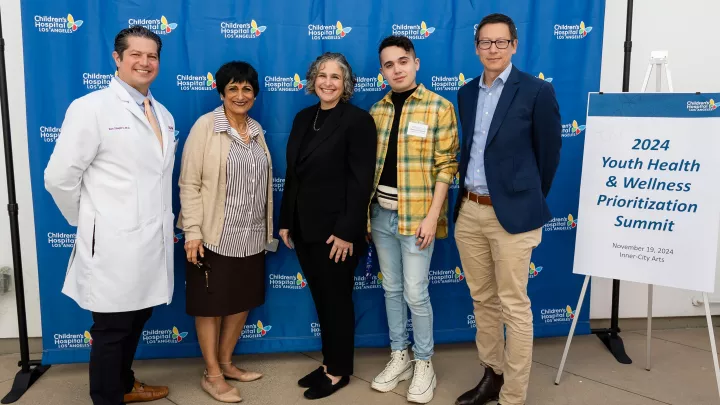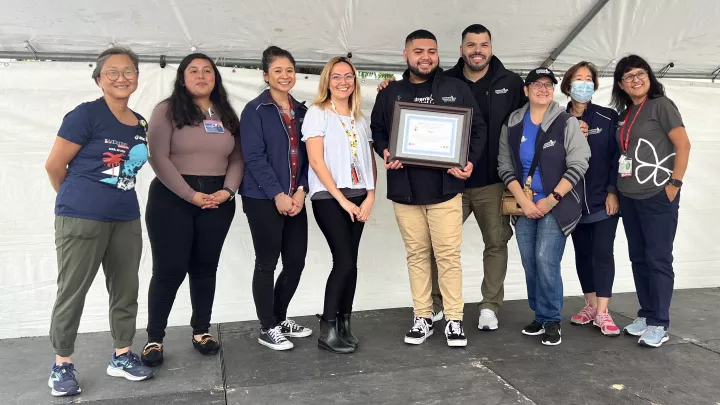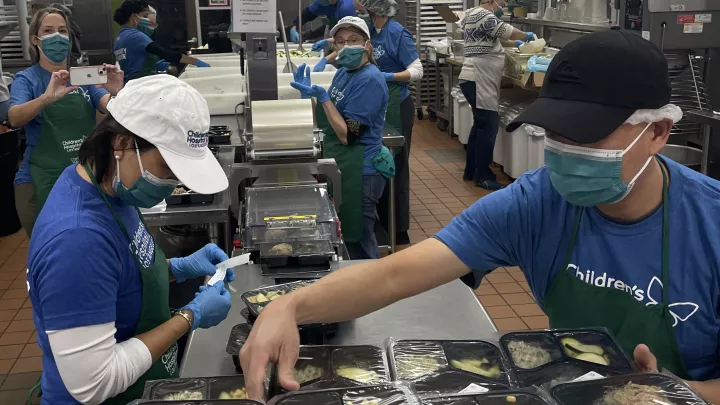
Susan Gantan, MPH, (far right of photo, standing) leads a meeting of the Children’s Health and Wellness Collaborative at CHLA.
The Children’s Health and Wellness Collaborative: Addressing the Community’s Most Urgent Health Needs
Addressing the needs of an entire community can’t be done alone. “Organizations in Los Angeles want to come together to build new collaborations,” says Susan Gantan, MPH, Senior Program Manager of Government and Public Policy Operations at Children’s Hospital Los Angeles. Gantan leads the Children’s Health and Wellness Collaborative, a team of L.A.-area organizations and stakeholders working to identify and collaboratively address the local community’s needs and concerns.
In addition to leaders from CHLA’s Behavioral Health Institute, Division of Adolescent and Young Adult Medicine, and other areas of the hospital, the Collaborative currently includes organizations such as the L.A. County Department of Public Health, the Los Angeles Unified School District, the L.A. County Youth Commission, the YMCA, the Boys & Girls Club, California Women, Infants & Children, First 5 L.A., Manos Que Sobreviven, the L.A. County Department of Economic Opportunity, and L.A. Care Health Plan. The list will grow as more organizations continue to join the Collaborative.
Finding an opportunity to do more

The purpose of the Collaborative, formerly known as the CHLA Community Benefit Council, has traditionally been to complete the Community Health Needs Assessment (CHNA), a survey conducted by the hospital in partnership with external consultants every three years to gather information on the health issues that community members view as most urgent. The assessment is sent to health care providers, social service organizations, parents, youth, and additional community stakeholders. The survey results help to inform how CHLA utilizes its resources to maximize the benefit to the region. Major needs identified in the last assessment, conducted in 2022, included economic instability, food insecurity, lack of access to mental health resources, and homelessness.
But Gantan and her colleagues recognized that they could accomplish much more than just conducting the survey and going their separate ways to address these pressing issues.
“Neither CHLA nor our community partner organizations have limitless resources to address every complex issue singlehandedly,” Gantan explains. “But we can amplify, partner with, or complement the work of one another to handle complicated needs.”
For instance, while CHLA does not provide housing, the hospital can help to address homelessness by working with and referring families to community partner organizations in the Collaborative that do. "And similarly, to address food insecurity, CHLA has partnered with community gardens and other organizations for which food security is their primary focus,” says Gantan.
She recognizes the importance of looking beyond the walls of the hospital. “Before our families come here and after they leave, they are part of the community,” Gantan says. “It’s important for us to see how we can make our community better, and I’m grateful to CHLA’s leadership for encouraging this.”
Susan Gantan, MPHBefore our families come here and after they leave, they are part of the community. It’s important for us to see how we can make our community better, and I’m grateful to CHLA’s leadership for encouraging this.
From surveys to summits
When this expanded iteration of the Collaborative was launched in June 2024, the participating organizations immediately started reaching out to other community stakeholders and forming focus groups. They also provided valuable insight for the Youth Health and Wellness Prioritization Summit, hosted at Inner City Arts in November 2024, an event that brought together almost 100 local leaders from health care, public policy, and education to review the most recent Community Health Needs Assessment and organize the community’s health-related needs in order of urgency.
“We followed that up with a meeting of the Collaborative in January 2025 to begin acting upon this feedback and forming partnerships,” says Gantan.
The meeting was a success. In addition to discussing large-scale issues with the full group, attendees took advantage of opportunities to have sidebar conversations about more specific and newly arising needs. From this one meeting came a handful of new memorandums of understanding—formal agreements on how entities will partner to achieve a goal.
“CHLA is seen as an anchor in the community and has built relationships with many different partners,” Gantan says. “So in leading this collaborative, we can bring together organizations that may not have interacted previously with one another." The group is now assembling a community benefit implementation strategy, which will detail the exact role each organization in the Collaborative will play in supporting the community.
Stronger together
The Collaborative will hold three or more full-group meetings per year to move these efforts forward. Members have also expressed interest in convening for smaller focus area forums to discuss potential collaborations to collectively address specific areas of need.
To Gantan, the future is bright. “I look around at all of our community partner organizations in the Collaborative, and each one is like a unique piece of fabric—they all offer something different, but they can be made even stronger when woven together,” she explains. “This is going to be an amazing, beautiful quilt.”


